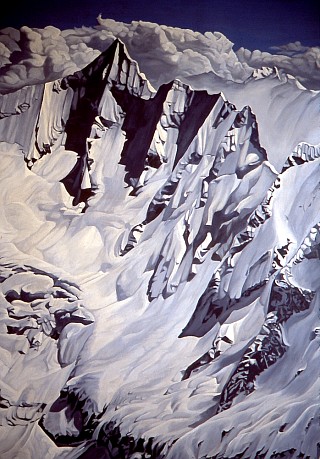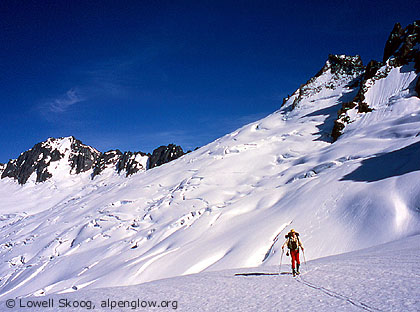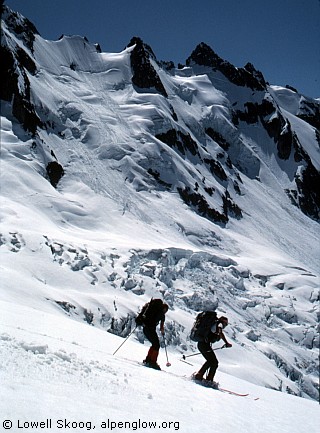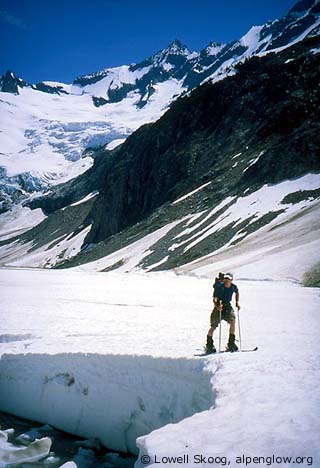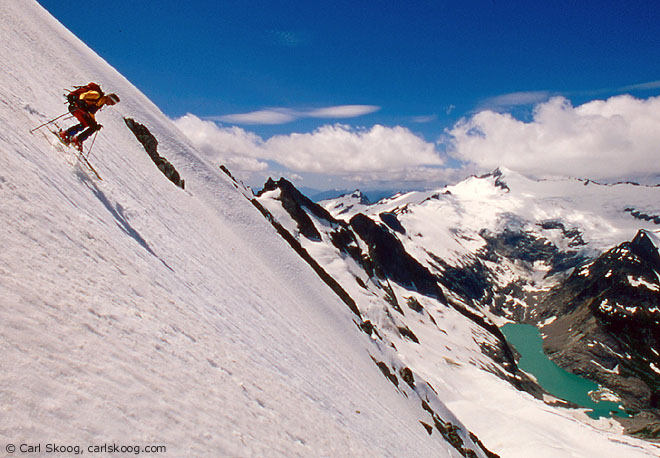

|
| Forbidden Peak from the northwest. The northwest face of the north ridge is the snow face left of the summit. Below the summit is the northwest face. To the right are the Forgotten Spurs. (Map, 200kb) |
|
Since I first climbed Forbidden Peak in 1977 with my brother Carl and two friends, this mountain has been a special place for me. Its chiseled features and beautiful surroundings continue to draw me back. I've scaled the mountain about a dozen times, by every ridge and by two of its three faces. In 1989, Carl and I added new routes of our own on the Forgotten Spurs, two ribs that ascend from the Forbidden Glacier to the west ridge. The north flank of the peak is my favorite, and most of my climbs of Forbidden have been made from this side.
As I extended my ski ventures in the North Cascades during the 1980s, Forbidden Peak drew me like a magnet. In May 1987, Jens Kieler (then Kuljurgis), Dan Nordstrom and I planned a ski traverse from Rainy Pass to Mount Logan and beyond. The logical finish for this route is at Cascade Pass, a variation that Carl and I completed in 1996. But in 1987 the attraction of Forbidden's north flank caused me to steer our route that way. From below Park Creek Pass we climbed to the Boston Glacier, then traversed to the north ridge of Forbidden. We skied the Forbidden Glacier down to Moraine Lake, crossed it, then climbed to Eldorado Peak and extended our traverse past The Triad to Sibley Pass. It was a magnificent and strenous five-day trip that we called the Thunder High Route. I wrote a story about the trip that appeared in the December 1987 issue of Climbing magazine. The article was poorly handled by the magazine editors, little noticed, and soon forgotten. To my knowledge, the route has never been repeated the way we did it. The shorter version Carl and I did in 1996, reaching Cascade Pass from Park Creek Pass by traversing south of Mount Buckner, has been skied a couple of times. In 1999, Martin Volken led a party of six on a four-day ski trip around Forbidden Peak, starting from the Cascade River and Boston Basin. They crossed Sharkfin Col and picked up our earlier route across the Boston Glacier. They crossed the north ridge of Forbidden Peak, descended to Moraine Lake, then climbed north from the lake toward Klawatti Peak. (Our 1987 route climbed west from the lake toward Eldorado Peak.) Volken's party made a side-trip to Austera Peak and back, then crossed the Inspiration Glacier to Eldorado Peak and returned to the Cascade River. Volken called his route "The Forbidden Tour" and included it in his 2002 guidebook, Backcountry Skiing Snoqualmie Pass. He continued to guide the trip each year after that, and the route has been written up several times, including an article by Andy Dappen in the November/December 2001 issue of National Geographic Adventure magazine. As a result, the Forbidden Tour has become the most popular multi-day ski traverse in the North Cascades.
In 2002, I decided to revisit the area to ski the Forbidden Tour. For novelty, I decided to try the trip as a flow day, a one-day circuit without overnight packs or camps. Traveling light and non-stop through high mountains is one of the finest experiences skis have to offer. I reckoned that the Forbidden Tour would be a good candidate for this style of trip (see map, 200kb). Bruce Goodson was eager to go. After hearing of our plans, Joe Catellani, Sean Courage, Garth Ferber, and Andreas Schmidt also signed on. We drove as far as we could up the Cascade River road on the evening of June 21 and slept for a few hours next to our cars. At 4 a.m. the next morning we hiked up the road to the Boston Basin trail carrying our skis. When we reached continuous snow in Boston Basin, we switched from sneakers to boots and skis. We skinned up the Quien Sabe Glacier and scrambled to Sharkfin Col. We rappeled over the col onto the Boston Glacier and traversed to the north ridge of Forbidden Peak, arriving around 10:30 a.m. Most of our party used alpine touring skis with plastic mountaineering boots. While not as good as specialized ski boots for downhill skiing, mountain boots are more agile for scrambling on rock and more efficient for long-distance touring. Sean rigged his skis with tip cords, which went from holes in his ski tips to a strap velcroed around each leg, just below the knee. They looked comical but were quite effective. He was able pull back on the cords to really crank turns in sloppy snow.
Facing east, the Boston Glacier catches the full strength of the morning sun. The snow there was soft and trappy, but it improved dramatically when we crossed to the northwest-facing slopes of the Forbidden Glacier. With our light packs, we delighted in carving turns on the firm corn snow of the glacier. We stopped often to take pictures and just soak up our surroundings. Below about 5500 feet, we found a snow ramp north of the Forbidden Glacier that cut through rock bluffs to the lower moraine. We removed skis to carefully descend the dirty moraine, then skied down ice-chunked avalanche debris to Moraine Lake, arriving a little after noon. The North Cascades are renowned for their tall summits, but Cascade lovers also admire their deep holes. Thousands of years of ice-age grinding have hollowed out cold and forbidding cirques throughout the range. North Cascade holes often are wilder, more remote, and less visited than the famous summits that tower above them. This is definitely true of the Forbidden Cirque. From Moraine Lake you gaze far, far up to rushing waterfalls, perched glaciers, tumbling icefalls, and rocky ribs that finally reach the summits. It is a great place to linger, look, listen and feel very small. We found Moraine Lake remarkably well frozen for late June. Skiing across it presented no difficulties. In 1987, in early May, the lake was not as solidly frozen as we found it on this trip. From the west end of the lake, we climbed north-facing slopes to the south edge of the Inspiration Glacier. This was the way I'd gone in 1987, and it was well snow covered, with no obstacles to climbing on skins. Martin Volken's 1999 route, which climbed south-facing slopes toward Klawatti Peak, was melted out with an unpleasant looking moraine at the bottom. It appeared to be more suitable as an early spring route. On the Inspiration Glacier, our party of six split into two groups. Garth, Joe and Sean were satisfied with what we had done already. They chose to ski to the head of the Eldorado Glacier and descend to the cars from there. Andreas, Bruce and I wanted to cap off the loop with an ascent of Eldorado Peak. We rested at the rocks below the peak, ate a little, and tried to recover our energy. Dropping everything except our skis and poles, we climbed slowly to the summit crest. Andreas and I arrived around 4 p.m. with Bruce following somewhat later. He was tired but happy to reach the top of this peak for the first time. Eventually we made our way down the Eldorado Glacier, crossed the ridge to Eldorado Creek, and descended the climbers trail to the Cascade River road, reaching our cars around 8 p.m. The day was as fine as any I've ever spent in the mountains.
A year later, my brother Carl and I returned to the Forbidden Cirque with steep skiing in mind. Carl plunged into the world of extreme skiing in 1997 with the first ski descent of the Edmunds Headwall on Mount Rainier's Mowich Face. I had observed the growth of steep skiing since the 1990s and was disturbed by what I saw. Extreme skiing, it seemed to me, was the ski mountaineering equivalent of unroped solo climbing. I was uneasy about the way the sport was promoted by the media and repelled by the way its risks were often glorified by the ski community. But as a student of skiing history, steep skiing was a phenomenon I could not ignore. Since the 1990s, it has become a persistent theme in the development of American ski mountaineering. Over the years I had skied enough steep terrain to have a pretty good idea of what it required, but my steep skiing had always been incidental, the unplanned convergence of favorable conditions and opportunity. Whether I skied or down-climbed or detoured around a particular slope had never much mattered to me. I had never planned a trip with the explicit goal of skiing a route where a fall might have serious consequences. Yet my curiosity about steep skiing grew. I wanted to gain more first-hand experience to better understand it. With Carl, I began dabbling in steeper terrain on peaks like Mount Hood, Mount Stuart, Hurry-Up Peak, and others. Forbidden Peak had long been special to me as a climber, and I envisioned bringing skis to the northwest face of the north ridge, the route by which Carl and I first climbed the peak in 1977. In June 2003, Carl and I hiked to Boston Basin and crossed Sharkfin Col to the Boston Glacier. We skied to the north ridge of Forbidden Peak, crossed to the Forbidden Glacier then bivouacked. On the morning of June 26 we kicked steps up the snow face of Forbidden's north ridge. I was determined that our climb and descent should be as complete as possible, so leaving our skis at the top of the snow face we climbed to the summit of Forbidden and back following the north ridge. The north ridge of Forbidden Peak is a beautiful alpine rock climb, and even if we didn't ski the face our trip was already a success. Around 2 p.m. we began our ski descent. At the top, Carl belayed me with the rope as I cut back and forth across the face on skis, trying to slough the loose surface snow. Only an inch or two of snow released, but that was enough to clear a path. The slough gained volume as it descended, becoming a roaring torrent by the time it reached the bottom of the face. Then I unroped and we took turns skiing. The moving skier would descend to one side, both for safety and for good pictures, then cut below and to the other side of the stationary skier, where he would anchor to an ice axe and stand while the roles were reversed. As I expected, the skiing was not technically difficult. I regularly push my technical skills harder skiing moguls at a ski resort. But skiing moguls I sometimes fall. On the north ridge of Forbidden Peak there was no room for error.
We completed the descent with care and returned to our bivi site for a second night. The next day we circled the mountain high on the Forbidden Glacier, climbing a gully that brought us to Torment Basin west of the peak. We'd hoped to ski the north face of Mount Torment as we passed by, but the face was split by a wall-to-wall bergschrund. Another party completed that descent with more favorable conditions the following year. I was satisfied with our safe and spectacularly beautiful descent, but I remained ambivalent about the idea of extreme skiing. Two years later, on Cerro Mercedario in the Andes of Argentina, Carl fell to his death on a slope less steep than the one we had skied on Forbidden Peak.
--Lowell Skoog
|
||||||||||||||||||||||||||||||||||||
|
Previous | Next | Overview - Skiing the Cascade Crest | The Alpenglow Gallery |
